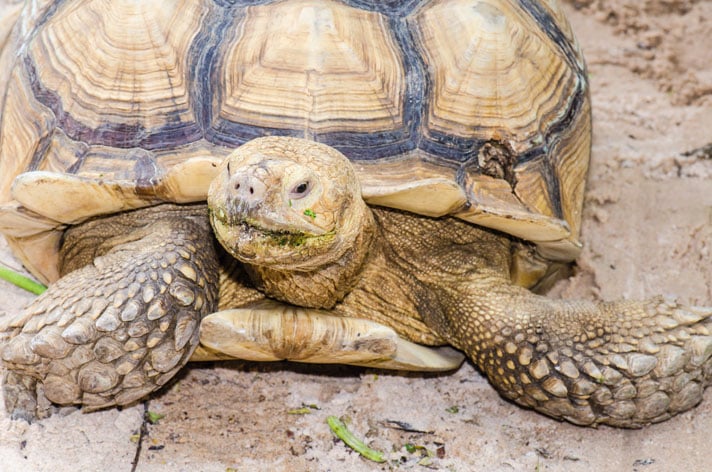Mixing species is by no means easy, and it is probably best left to the most experienced herpkeepers.
My obsession with herpetoculture began in the early 1990s, when I was about 8 years old. I was concurrently obsessed with aquaculture, and I often found myself asking, “Could I make a community herp tank, just like I do with my fish?” So, I started looking into it, and the results I got were pretty mixed from the literature available at the time. The majority of the literature said it was doable, but provided little guidance as to who could live with whom without issue, so I began to experiment. Like the literature, my results were mixed. By the dawn of the Internet age I was horrified to discover that, in the opinions of many, mixing species was absolutely taboo. I abandoned my mixed tanks immediately. Fast forward 14 years, when I became an animal keeper at the local zoo. It was with this job that I got schooled in the proper way to have successful mixed-species vivaria, finding that it is possible, but it takes a lot of planning and a little bit of luck.
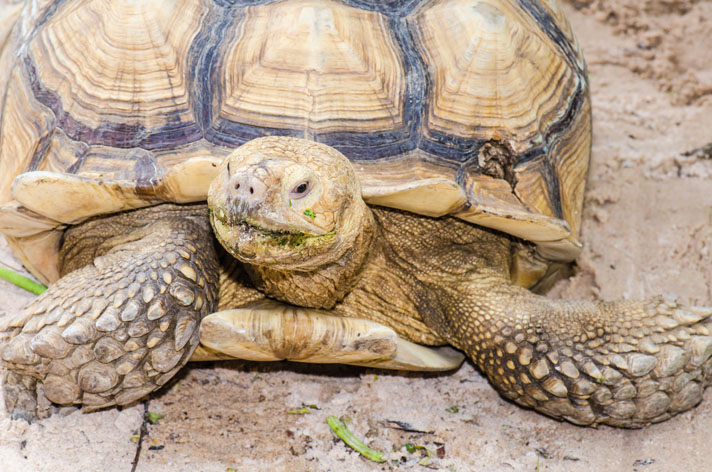
shutterstock/kobchaima
The African spur-thigh tortoise could be kept with leopard tortoises.
Why Do I Want a Mixed-Species Vivarium?
This is the first question you should ask yourself. Honest answers to this seemingly rudimentary question will let you know if you are ready for the undertaking. If you are new to the hobby, I recommend against mixing until you become a master of the basic husbandry techniques to successfully maintain a single species.
Do you want to mix species to show how different species occupy different niches within the same habitat, each etching out their own living in a complex environment? Do you want to mix species to highlight the diversity of a habitat? What is your reason to want to take on this challenge?
A Lot Can Go Wrong
It may seem obvious, but mixing species can have a lot of pitfalls. There is a very good reason many herpers consider mixing species to be taboo; a fool’s undertaking, if you will. As such, you must be prepared to tackle any problems should they arise. First, a proper environment for multiple species can be hard to achieve—what is good for one species may be detrimental to another. You need to be able to provide an idyllic environment for all species, which can require some creativity on your part.
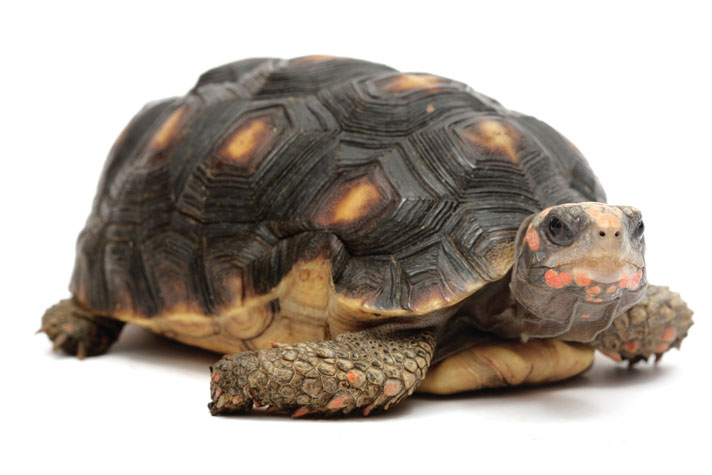
gina cioli
The red-footed tortoise could be kept in a large enclosure with a green iguana.
Next, animals can spread disease to each other. You need to have a good quarantine system to ensure only healthy specimens make it into the community setup, and you need to be vigilant about monitoring your animals for signs of disease. A good working relationship with a qualified herp veterinarian is vital, as the veterinarian can help ensure you are only placing healthy, parasite- and disease-free animals into the environment together.
Also, animals can fight. It would amaze you how quickly two animals that co-existed peacefully for years can turn on one another under certain circumstances. Herp fights can be violent, even deadly. Again, the vet and a quarantine space will come in handy here. It is good to also keep in mind that intimidation from one specimen to another can be just as bad as physical altercations. Some animals do not need to physically attack one another for one animal to start showing signs of chronic stress.
Lastly, remember that animals are individuals. Just because a friend of yours was successful keeping two different species together will not automatically ensure you can replicate those results. Just like in fish keeping, there are guidelines as to who can live with whom, but you need to be prepared for the possibility of a peaceful animal being not so peaceful.
Some General Guidelines on Keeping Mixed Species in a Vivarium
Now that I’ve covered some of the possible problems you may run in to, I can give you what I consider to be sound guidelines on how you can be successful building mixed species vivaria.
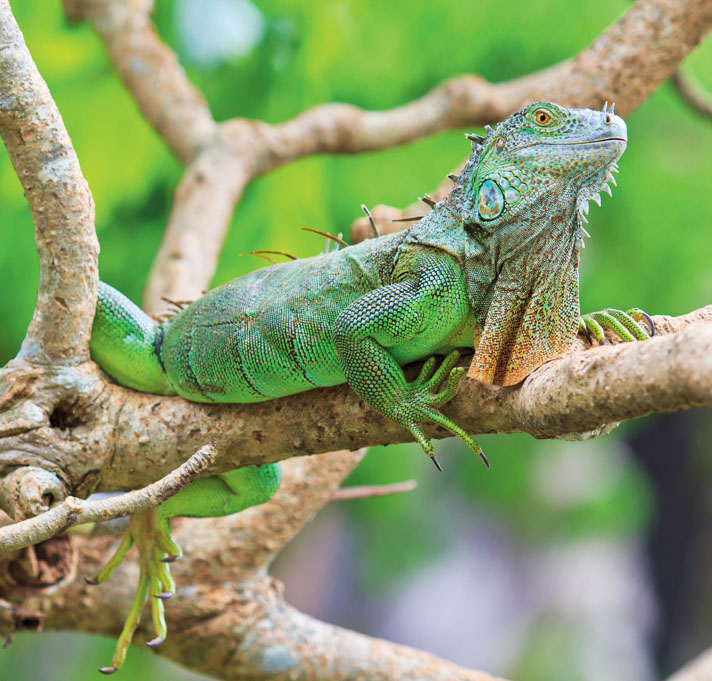
shutterstock/apiguide
Green iguanas can be kept with ground-dwelling species, such as some tortoises.
- Quarantine is a must. All animals you wish to house together should be quarantined. Quarantine is the process of keeping an animal in a simplistic, species-appropriate enclosure, separate from all other animals, for the purpose of determining good health. Ideally, quarantined animals would be in a separate room from your existing animal collection, and any maintenance of those animals would be performed after you have tended to your existing collection and washed up thoroughly. I recommend a minimum quarantine period of 60 days, with at least two fecal parasite exams being performed two weeks apart. Obviously, this is an instance where a veterinarian’s services are needed. Any positive fecal exam results or signs of ill health will lengthen the quarantine period. I cannot overstress the importance of quarantine. To ignore quarantine is tempting fate, especially when mixing species.
- Choose species carefully. This seems obvious, but I would be remiss to not mention it. Clearly, predator-prey dynamics should be avoided, as should mixing animals from vastly different habitats. Hognose snakes would make poor cagemates for American toads, and rain forest frogs should not be kept with desert geckos for these respective reasons. A less apparent aspect of species selection is competitive dynamics—that’s to say, will animal A directly compete with animal B for food, basking areas, sleeping areas, etc. Well-thought-out mixed-species setups aim to minimize competition. For example, mixing terrestrial poison frogs with small arboreal tree frogs would minimize competition for territory, as the tree frogs have no interest in being on the ground and the poison frogs would not inhabit high foliage.
- The habitat must be appropriate for all. Here is another seemingly obvious point that cannot be overlooked. It is for this reason that I prefer to only house animals together that inhabit the same ranges and habitats, as their requirements are likely to be similar. Even here, things can get tricky; keep in mind that while green anoles and green tree frogs inhabit similar ranges and habitats, the basking lights that the anoles require would have a desiccating effect on the frogs, so the enclosure should be big enough to allow for a basking spot for the anoles while not drying out the enclosure and harming the frogs. Again, you must minimize competition by providing multiple basking sites if you’re housing two basking species together, and multiple water bowls, hiding areas and feeding sites, etc. The less the animals have to compete, the more likely you are to be successful!
- Cages for multiple species need to be bigger. This is plain and simple. Say you have two species that can each reside happily in a 10-gallon aquarium. This does not mean both species can share a 10-gallon aquarium. When housing multiple species, you need to afford as much space to the vivarium as possible, especially if two species inhabit the same micro-habitat, such as two species of aquatic turtle. As a rule of thumb, when mixing species, I recommend doubling the recommended enclosure size for each species you plan on housing together and adding those spaces together. For example, many people recommend that a single red-eared slider be given a 125-gallon aquarium or similar-sized space at a minimum, while recommending a 75-gallon aquarium for a Mississippi map turtle. If I were to house a red-eared slider with a Mississippi map turtle, I would do so in a space equal to a 400-gallon aquarium (125 gallons x 2 + 75 gallons x 2 =400 gallons), with at least two basking sites, two UVB bulbs, two feeding stations and adequate filtration for the whole setup. The larger the space, the less likely the two species will compete with each other for resources, and in the event of a fight, there is more room for the victim to get away from the aggressor.
- While providing such copious amounts of space may seem exorbitant, you and your animals will both be better off in the long run if the space afforded to them reduces stress and chances of conflict between species.
- Keep it clean. Serious attention must be paid to hygiene in any setup, but when housing multiple species together the importance of doing so grows exponentially. A good analogy is a human one: Would you want to eat off a dish that another animal has crawled on, or would the disease risk bother you? While animals have no concept of disease transmission, you do. So, it is up to you to reduce the risk. Spot-clean feces as soon as you notice them, regularly disinfect food and water bowls, cage furniture, the cage itself (if practical), etc. Failing to maintain regular, hygienic husbandry is another way you could invite disaster into your mixed-species vivarium.
- Keep an eye on things. My final, seemingly obvious guideline is to keep a close eye on all the animals in your setup. Any animal that seems to be weak, malnourished, sick, stressed, etc., should be removed into quarantine for evaluation immediately, and a vet visit may be in order. This ties in to what was mentioned earlier about differences in individual animals. Let’s say you have a vivarium housing two different poison frog species, and you have three frogs of each species. You notice one doesn’t seem to be coming out for food, always avoids the other frogs and seems to be losing weight. You place the frog into quarantine and it recovers, but when you return it to the tank, the cycle repeats itself. That animal should be kept alone, even though its comrades of the same species are doing fine in a mixed situation. It is for this reason that I recommend weighing your animals at least once a month and keeping that information written down in a notebook for comparative purposes. A decent gram scale is an indispensable tool to the herpkeeper, too, especially one who wishes to mix species.
How to Select Compatible Species
Now that we’ve reviewed guidelines for a successful mixed-species enclosure, let’s go over a few guidelines for compatibility, because species selection can be the hardest aspect of setting up a mixed-species tank.
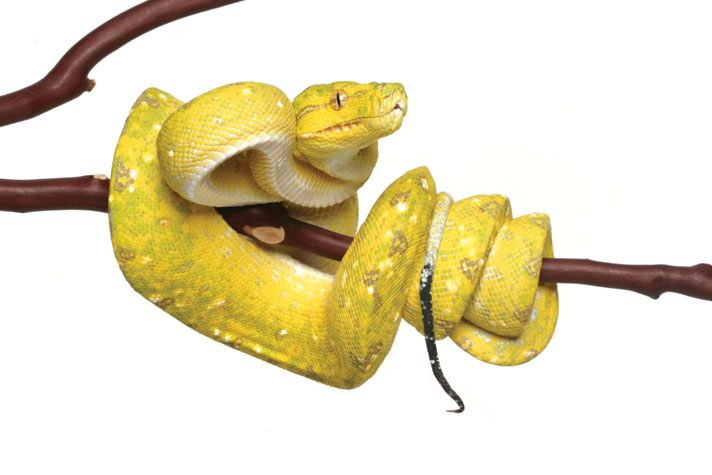
Gina cioli
An arboreal snake, such as this green tree python could be kept with an aquatic animal that won’t compete for the branches in its large vivarium.
- Keep predators and prey separate. I mentioned this earlier, and it seems pretty elementary, but sometimes people will overlook possible predator-prey relationships. Big herps will often eat smaller herps; this is especially true of turtles, lizards and frogs. Some snake species will eat other snake species, too, including kingsnakes, milk snakes, indigo snakes, cribos and mussurana. Even snakes that feed primarily on insects, such as rough green snakes, are known to occasionally prey on small frogs and lizards. So know the dietary preference of all species, and avoid any possible conflicts.
- Do not house aggressive species with passive ones. Even though an eastern mud turtle would not prey upon a similarly sized map turtle, mud turtles are notoriously territorial and will aggressively pursue a passive species, such as a map turtle, and bite at the animal, causing stress and injury. Know the personality type of all species involved, and try to house like with like. Aggressive species are best housed alone, of course.
- Minimize conflict. The best candidates for a mixed species setup are species that will interact, and therefore compete, in a minimal way. If one species is terrestrial, and the other fully aquatic or arboreal, they won’t compete for territory as much as two terrestrial species. If one species is diurnal and the other nocturnal, they will have opposing sleeping schedules, and as such, will stay out of each other’s way. If one is an insectivore and the other an herbivore, they won’t compete for food. The list goes on and on, and this is perhaps the most “gray” area of mixing species, as a lot of exceptions and contingencies can be in place here. As a general rule, the more you strive to reduce competition, the better off everyone will be.
- Similar habitat is a must. You cannot expect two species to be compatible if they are from drastically different biomes. Woodland species will not do well in tropical rain forest setups, nor will rain forest species in woodland setups. Desert species would quickly perish in a riparian setup, while a riparian species would certainly die in a desert setup. As mentioned earlier, species that inhabit the same habitat in the wild are your best bets for possible compatibility in captivity, assuming they won’t eat one another or out-compete one another.
- “Mixed species” doesn’t necessarily mean herps with herps. The final point I would like to make regarding selecting compatible species is that you shouldn’t limit yourself to just herps. Many interesting mixed species setups have been made by mixing taxa, such as herps and fish, herps and insects, herps and birds, or even herps and mammals. In many instances, non-herps are the best species to mix with herps because they are less likely to bother each other or to transmit disease to one another. If you are not confident in your ability to successfully maintain non-herps, however, avoid adding them to your mixed-species setups.
Examples of Mixed-Species Vivaria
It is possible to mix species within a single vivarium, provided a lot of planning takes place when selecting species that could live together and a lot of attention is paid to creating a proper environment for all species involved, especially in regard to habitat type and enclosure size. The following are some examples of species that could potentially make good cagemates for one another. These are species that I have either mixed personally or have seen others do so successfully. I’ve broken them down by how they could be housed together, based upon the habitat they commonly inhabit: tropical rain forest, temperate woodland, desert, riparian/semi-aquatic and tropical savanna.
Tropical Rain Forest Vivarium
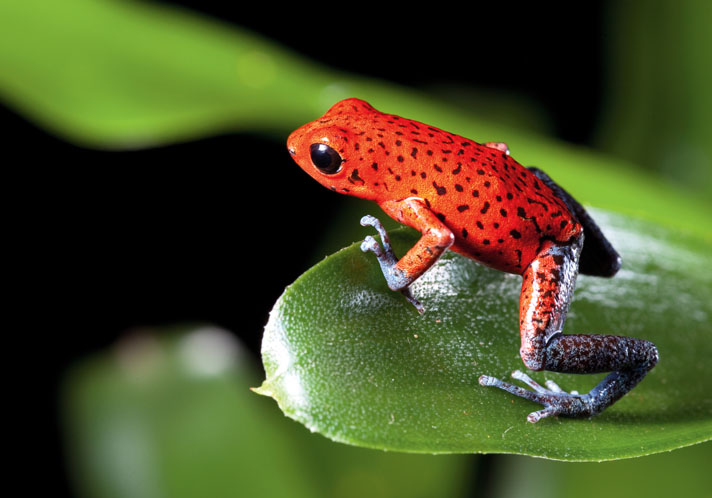
shutterstock/dirk ercken
Certain poison frogs, such as those from the genera Phyllobates, Dendrobates, Adelphobates and Oophaga, can make suitable tank mates.
Characterized by warm temperatures (80-plus degrees Fahrenheit) during the day, high humidity and lush, plentiful foliage. This is the biome from which many herp species commonly found in the trade are naturally found. The following are types of mixed species situations that could work well with animals from this biome.
- Poison frogs with poison frogs. Many people have found that certain poison frogs, such as those from the genera Phyllobates, Dendrobates, Adelphobates and Oophaga, can make suitable cagemates. I recommend allowing a minimum of 10 gallons of space per frog kept in such a situation, and I have personally found that D. tinctorious, D. auratus and D. leucomelas do well living together, provided plenty of cover and food is available.
- Poison frogs with emerald tree boas. OK, this may sound a bit controversial, but poison frogs (namely Dendrobates spp.) and emerald tree boas (Corallus caninus) work out pretty well together, provided that the boa is an adult when introduced to the frogs (juvenile emerald tree boas may try to prey on the frogs). Use a radiant heat panel to provide warmth to the boa in this situation, and use an enclosure that is at least 4 feet long, 2 feet wide and 3 feet tall, with plenty of sturdy, horizontal branches for the boa to use. Such an enclosure can house a single boa with about six poison frogs.
- Arboreal snake with aquatic animal. I have seen multiple variations on this theme, with Amazon tree boas (Corallus hortulanus), emerald tree boas (C. caninus), eyelash vipers (Bothriechis schlegelii) or green tree pythons (Morelia viridis) being used for the snake species, in an enclosure where the arboreal perches overhang and protrude from a body of water that is inhabited by various species of fish (such as tetras and angelfish for the South American snakes or rainbow fish and gouramis for the tree python), or the pipa toad (Pipa pipa) in the case of the South American snakes. A land area should be provided in case the snakes want to come down, and heat should be provided by a radiant heat panel. Obviously, the water will need filtration and to be occasionally changed in such a setup. Minimum dimensions of 4 feet long, 2 feet wide and 3 feet tall are recommended, and proper safety protocol should be observed if the venomous eyelash viper is to be included.
- Red-footed tortoises and green iguanas. Both of these herbivorous reptiles can exist together harmoniously, given enough room to roam (tortoises) or climb (iguanas). I recommend an enclosure at least 10 feet square with a height of at least 6 feet, with plenty of sturdy branches, logs and multiple basking sites at both low and high levels, each also providing UVB radiation. Outdoor enclosures in suitable climates would be best.
Temperate Woodland Vivarium
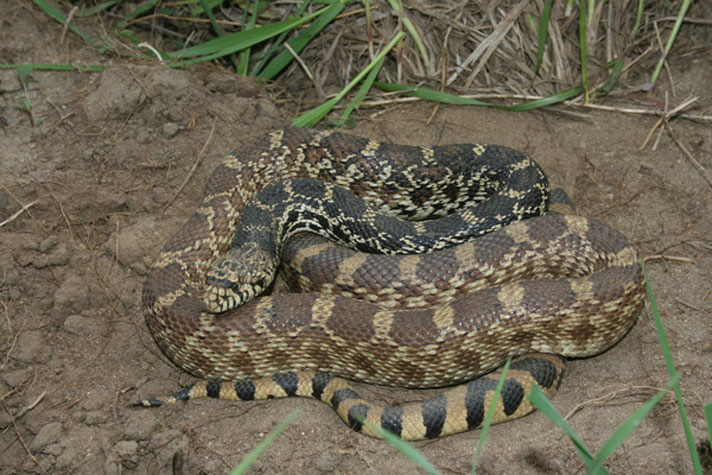
Psyon/Wikipedia
Bullsnakes could be kept with pine snakes or ratsnakes.
These are characterized as any sort of forested to semi-forested area located in a temperate zone. They frequently undergo extreme seasonal variations, and are the habitats of many commonly available herps.
- Eastern box turtles and corn/rat/pine snakes. The eastern box turtle and rat and pine snakes can be found over much of the same range throughout the southeastern United States, often in the same habitat. For this mix, I recommend an enclosure that is at least 8 feet long, 4 feet wide and 3 feet tall, with plenty of climbing options, hiding spaces, at least one large shallow water bowl and at least two basking sites. Such an enclosure could house two to three turtles and a pair of rat snakes or a single pine snake. The snakes should be adults to avoid possible injury by a raucous box turtle.
- North American rat snakes and pine/bullsnakes. The North American rat snakes of the genus Pantherophis, which includes corn snakes, black rat snakes, yellow rat snakes, Baird’s rat snakes, etc., can successfully be maintained with snakes of the genus Pituophis, namely the bullsnake (P. cantenifer sayi) and the pine snake (P. melanoleucus). All snakes should be adults when introduced, and the cage should be at least 6 feet long, 3 feet wide and 4 feet tall, with plenty of climbing/hiding opportunities. Offer at least one heat source per snake. Up to three rat snakes and a single pine or bullsnake or two pine/bullsnakes and a single rat snake can live together in such an enclosure.
- Different North American rat snake species. In an enclosure that is at least 4 feet long, 2 feet wide and 3 feet tall, you could successfully maintain two individual rat snakes of different species—black rats with yellow rats, yellow with red rat snakes (aka corn snakes), black with red, Baird’s with yellow, etc. Add a foot in all directions for each additional specimen, and keep in mind they can hybridize. I recommend against incubating any eggs from such a setup.
Desert Vivarium
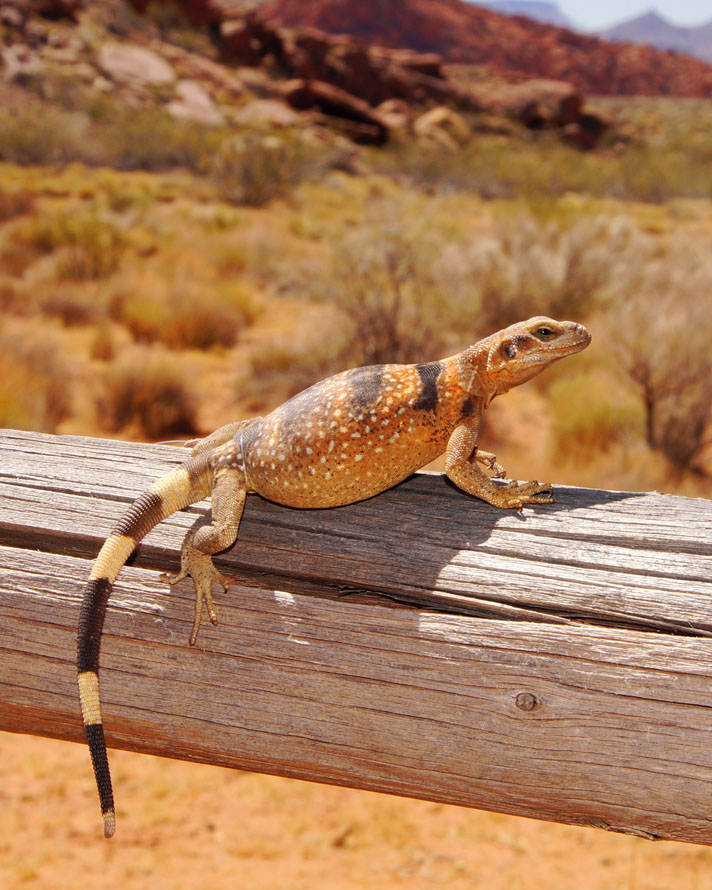
shutterstock/matt jeppson
Chuckwallas could be kept with desert iguanas.
Hot during the day, cool at night with little annual rainfall, deserts are undoubtedly a rough place to carve out a living. Many herps do so in style, though.
- Desert iguanas and chuckwallas. These two North American desert dwellers can live together quite comfortably, provided plenty of terrestrial space is given and all animals are similar in size to prevent bullying. Offer multiple basking/UVB sources, as well as plenty of hide spots for these animals in an enclosure measuring at least 6 feet long, 4 feet wide and 2 feet tall for a single specimen of each species. Add an additional 3 square feet of floor space per specimen.
Riparian/Semi-Aquatic Vivarium
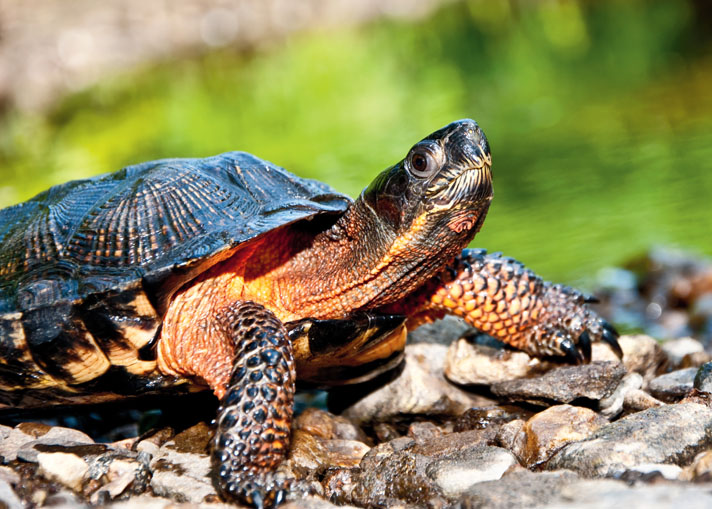
shutterstock/jayondreicka
Wood turtles could be kept with spotted turtles.
Ah, the water’s edge. Typically a cornucopia of life, these habitats also provide many decent opportunities to safely mix species. Turtles certainly dominate this category. For all these recommendations, I suggest at least 4 square feet of space per animal, with a water depth of 1 foot.
- Different slider turtle species. There are plenty of sliders that make good roommates for each other—red-eared sliders with yellow belly sliders, red-eared sliders with Cumberland sliders, Cumberland sliders with yellow belly sliders, etc. Provide plenty of room, multiple basking sites and avoid extreme size differences, and the sliders do well together.
- Slider turtles with map turtles. Generally speaking, any of the slider and map species should get along fine, provided they are of similar size, have plenty of room and are not competing for basking sites.
- Painted turtles and map turtles. Again, make sure the turtles are of similar size and have their own basking areas.
- Wood turtles and spotted turtles. In the case of these two species, make sure there is plenty of land area, and make the water a bit shallower—about 8 inches should be a sufficient depth.
Tropical Woodland Vivarium
There are quite a few herp species that inhabit tropical savanna—habitat that is too dry to be rain forest, but too wet and vegetated to be desert.
- Sulcata and leopard tortoises. This is a mix I have observed several times, and it tends to work, but it must be noted that both species are prone to territorial bouts, so extra careful attention must be paid. I recommend an enclosure measuring at least 20 feet long, 10 feet wide and 4 feet tall, obviously outdoors, for a single adult of each species. Add 10 square feet of floor space per animal added to the pen.
Obviously, these examples are nowhere near all inclusive of the possibilities out there. They are examples of mixed-species vivaria that I have either maintained personally in the past, currently, or successfully maintained by my colleagues at other zoological parks. They are also not lists of guaranteed success either; mixed-species vivaria always carry a certain degree of risk and should only be attempted after much thought and preparation is done on the part of the keeper to ensure a harmonious existence for all species involved.
Are You Ready for the Challenge?
Mixing species can be loaded with potential—potential for a rewarding vivarium or for disaster. How well your mixed-species enclosure turns out depends on how much time and effort you put into planning and setting it up, and how well you plan for unexpected outcomes, such as incompatible individuals.
Many hobbyists write off setting up such a vivarium based upon the potential for failure alone, which is perfectly reasonable. However, telling people to not mix species because it is “impossible” or “foolish” is simply inaccurate. Mixing species is by no means easy, and it is probably best left to the most experienced herpkeepers, as they will be more experienced in detecting abnormal behavior or correcting environmental problems such as low humidity or improper temperatures. That’s not to say novices can’t set up a successful mixed-species vivarium; I just recommend they get some experience under their belts first. I have found mixing species, and watching them interact as they would in nature, to be a reward as great as any in the hobby. Good luck!
Ashley Troy Quick is a 2006 graduate of West Virginia University with a B.S. in Animal and Veterinary Sciences. Since first breeding fire-bellied toads in 1992, he has kept and bred 76 species of herps, including tentacled snakes, Panamanian golden frogs, hellbenders and Uroplatus geckos. He lives in Wheeling, WV where he works as an animal keeper at Oglebay’s Good Zoo.

